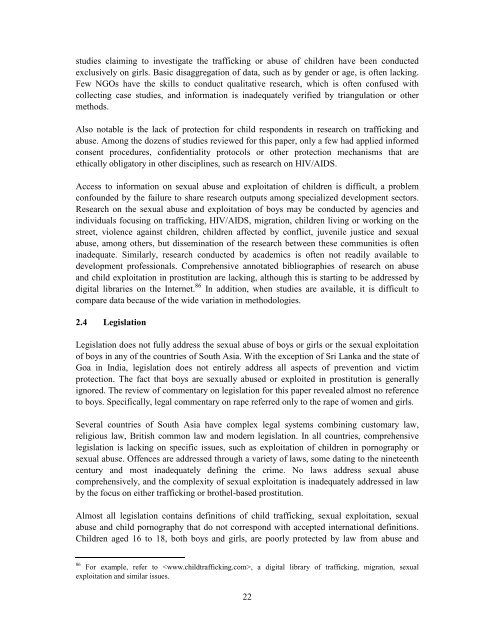SEXUAL ABUSE AND EXPLOITATION OF BOYS IN SOUTH ASIA A ...
SEXUAL ABUSE AND EXPLOITATION OF BOYS IN SOUTH ASIA A ...
SEXUAL ABUSE AND EXPLOITATION OF BOYS IN SOUTH ASIA A ...
You also want an ePaper? Increase the reach of your titles
YUMPU automatically turns print PDFs into web optimized ePapers that Google loves.
studies claiming to investigate the trafficking or abuse of children have been conducted<br />
exclusively on girls. Basic disaggregation of data, such as by gender or age, is often lacking.<br />
Few NGOs have the skills to conduct qualitative research, which is often confused with<br />
collecting case studies, and information is inadequately verified by triangulation or other<br />
methods.<br />
Also notable is the lack of protection for child respondents in research on trafficking and<br />
abuse. Among the dozens of studies reviewed for this paper, only a few had applied informed<br />
consent procedures, confidentiality protocols or other protection mechanisms that are<br />
ethically obligatory in other disciplines, such as research on HIV/AIDS.<br />
Access to information on sexual abuse and exploitation of children is difficult, a problem<br />
confounded by the failure to share research outputs among specialized development sectors.<br />
Research on the sexual abuse and exploitation of boys may be conducted by agencies and<br />
individuals focusing on trafficking, HIV/AIDS, migration, children living or working on the<br />
street, violence against children, children affected by conflict, juvenile justice and sexual<br />
abuse, among others, but dissemination of the research between these communities is often<br />
inadequate. Similarly, research conducted by academics is often not readily available to<br />
development professionals. Comprehensive annotated bibliographies of research on abuse<br />
and child exploitation in prostitution are lacking, although this is starting to be addressed by<br />
digital libraries on the Internet. 86 In addition, when studies are available, it is difficult to<br />
compare data because of the wide variation in methodologies.<br />
2.4 Legislation<br />
Legislation does not fully address the sexual abuse of boys or girls or the sexual exploitation<br />
of boys in any of the countries of South Asia. With the exception of Sri Lanka and the state of<br />
Goa in India, legislation does not entirely address all aspects of prevention and victim<br />
protection. The fact that boys are sexually abused or exploited in prostitution is generally<br />
ignored. The review of commentary on legislation for this paper revealed almost no reference<br />
to boys. Specifically, legal commentary on rape referred only to the rape of women and girls.<br />
Several countries of South Asia have complex legal systems combining customary law,<br />
religious law, British common law and modern legislation. In all countries, comprehensive<br />
legislation is lacking on specific issues, such as exploitation of children in pornography or<br />
sexual abuse. Offences are addressed through a variety of laws, some dating to the nineteenth<br />
century and most inadequately defining the crime. No laws address sexual abuse<br />
comprehensively, and the complexity of sexual exploitation is inadequately addressed in law<br />
by the focus on either trafficking or brothel-based prostitution.<br />
Almost all legislation contains definitions of child trafficking, sexual exploitation, sexual<br />
abuse and child pornography that do not correspond with accepted international definitions.<br />
Children aged 16 to 18, both boys and girls, are poorly protected by law from abuse and<br />
86 For example, refer to , a digital library of trafficking, migration, sexual<br />
exploitation and similar issues.<br />
22










